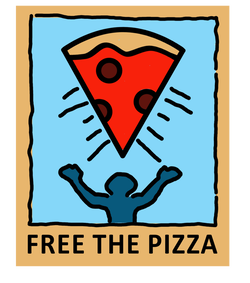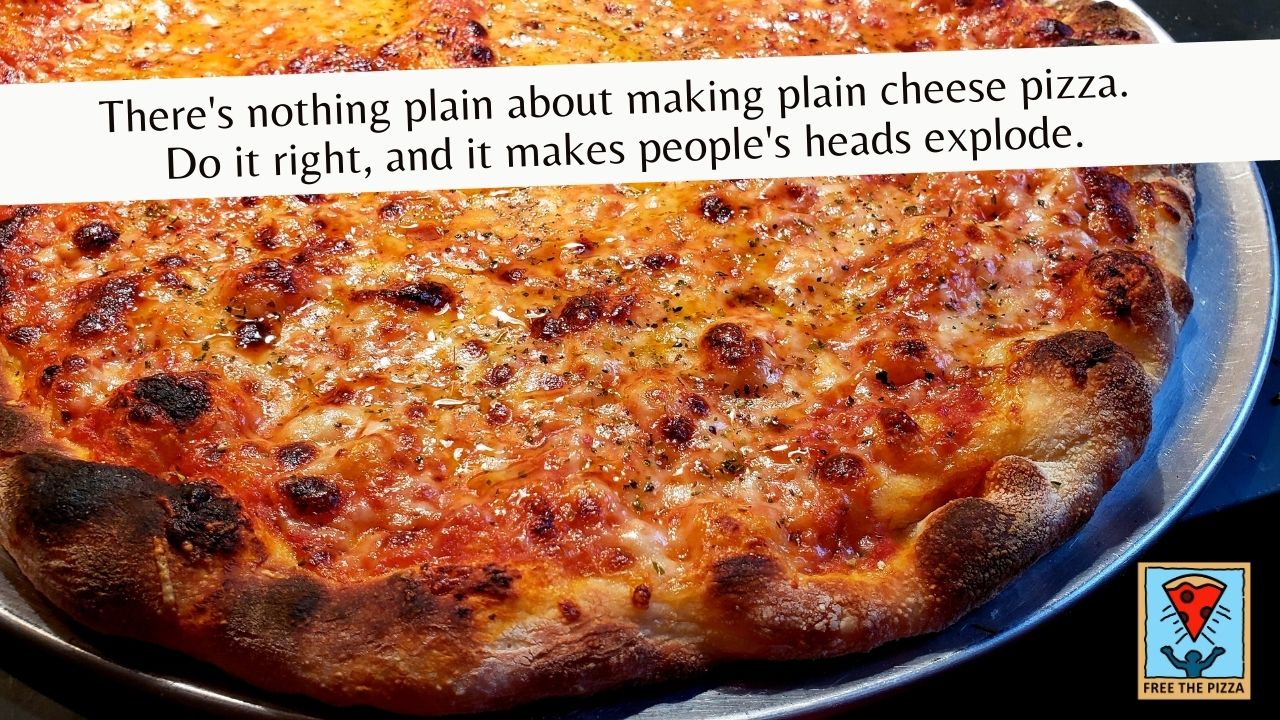|
I’m going to get grief for this, and that’s OK. You can believe me or not. I have a foodie friend who’s eaten about a dozen of my pizzas in recent years. A few weeks ago, she took a bite of a plain cheese pizza I’d just made. She said, “Oh, my. Of all of your pizzas, I think this is my favorite.” I made the same pizza again a week later and she was there. She took a bite and just groaned. Her husband took a bite and said, “This is incredible.” (The actual pizza we're talking about is the one in the photo up top: a 15-inch homemade pizza baked on steel in an old DCS home oven.) As a home pizza maker, one of the smartest things you can do is master the plain cheese pizza. It’s such a simple pizza, some consider it not worth the effort. I always recommend that it be the first pizza a newbie makes. That's because it tells you so many things about your oven, your new pizza habit and you.
The plain cheese pizza is worth mastering precisely because it IS simple. Crust, tomatoes and cheese. There’s nowhere to hide when you make a cheese pizza. No toppings to distract anyone. Just the simplest of pizza joys (or not). This is also going to sound counterintuitive. The reason I’ve been working on this pizza is I’ve been dialing in my recipe for New York-style pizza. My next book is about how to make a legit NY pizza in your home oven. And when I say legit, I’m talking about a pizza that raises the bar on what you might perceive as New York-style. This pizza will have a flavor and behavior like what you get as a traditional New York pie—but it should also be the best tasting New York pizza you’ve ever tried. The reason this works is because, as home pizza makers, we have a certain luxury: we have the time and the money to raise the bar on what happens in a typical New York pizzeria. (Note: I said "typical." We're not talking about any of the most famous New York pizzerias with coal-fired ovens and so many generations of great that its impossible to not love them. We're talking about the kind of competent New York-style pizza most Americans have experienced.) The typical New York pizzeria’s job is volume and consistency. They're busy cranking out hundreds of pizzas daily for hungry, on-the-go New Yorkers As amateurs, our job gets to be making the best pizza we can with the tools we have. Nobody is walking up to our kitchen window to buy a slice every few minutes. We are working on craft, not commodity. Most New York street pizzas have a pale cornicione, or outer rim. It often gets thrown away. Your pizza can have a nicely browned cornicione, perhaps with spots of char. It will taste great by itself. Nobody will want to throw it away. Most New York street pizzas are made with a canned pizza sauce that’s of acceptable quality. Yours can be made from the best tomatoes you want to buy. (I’ve recently been replacing my preferred DOP-stamped San Marzano tomatoes from Italy to Bianco DiNapoli organic tomatoes grown in California. They’re every bit as good as San Marzano. Perhaps better.) My sauce is also cooked down somewhat, and contains olive oil, dried basil, dried oregano, black pepper, white pepper and red pepper, and salt. Purists will tell you this is evil. I will tell you that it’s flavor. Most New York street pizzas use a shredded low-moisture mozzarella that may or may not be of decent quality. I’ve been using a premium brand that tastes as good as low-moisture mozzarella can taste. (Purists are going to claim that this is the wrong cheese, that the only cheese is fresh bufala mozzarella. Have at it—but it’s not a New York pizza.) Most New York street pizzas may or may not use a grated hard-aged cheese like Romano, parmesan or sharp provolone. I use pecorino Romano (tangy and spicy), Parmigiano Reggiano (sharp and nutty) and aged sharp provolone (rich, salty, and sweet) combined equally in a blend. This adds umami and complexity that lingers. Most New York street pizzas might include a drizzle of olive oil and a sprinkle of dried oregano to finish. My pizza always includes a drizzle of a fine Italian olive oil and a sprinkle of organic dried oregano. Same idea—better ingredients. Understand, this is not bragging. We’re talking about the incremental differences that may or may not piss off the purists, and will also lead to a style of New York pizza that tastes more elevated than a typical New York pizza product. I’m making a pizza that raises the bar. You can do it, too. We’re talking about a pizza that at once evokes memories of New York pizzas past while being memorable itself. It’s a pizza that, on paper, looks similar to a traditional New York cheese pizza. But all of the small things you do to elevate it lead to a pizza that makes people wonder why they’ve never had pizza like this before. And it also makes them wonder how it came out of a home oven. After all, a home oven is small and inferior and incapable of delivering a professional product, right? Wrong. The oven is just a tool. And our home oven is a compromise. But by adding additional tools, like steels and peels, the home oven becomes a force for pizza good. And when you practice pizza (for make no mistake, pizza is not just a recipe but a practice), you continue to raise the bar and get better at it. And you can end up making a pizza that (as one friend puts it) ruins your guests for any other pizza anywhere. And yes, that statement above is an exaggeration. I do not make anything like the best pizza in the country. I’ve eaten at those pizzerias. It’s a much different experience. And so is your homemade pizza when you crank it out of your home oven with your own style, your own sensibility, and your own love for the people you’re serving it to. There are so many things that go into making a pizza. And the most important ingredient is you and what you decide to bring to it. ----------------------------- The New York pizza book is not out yet. But if you want to begin your pizza journey, and learn many of the basic skills using your home oven and some basic tools, this is the simplest and perhaps silliest book that can get you started: the award-winning pizzamaker’s manual, Free The Pizza: A System For Making Great Pizza Whenever You Want With The Oven You Already Have by clicking here. If you want notification when the book is available this fall, sign up for the mailing list for this blog.
0 Comments
Leave a Reply. |
AuthorBlaine Parker is the award-winning author of the bestselling, unusual and amusing how-to pizza book, Free The Pizza. Also known as The Pizza Geek and "Hey, Pizza Man!", Blaine is fanatical about the idea that true, pro-quality pizza can be made at home. His home. Your home. Anyone's home. After 20 years of honing his craft and making pizza in standard consumer ovens across the nation, he's sharing what he's learned with home cooks like you. Are you ready to pizza? Archives
July 2024
Categories
All
|
© Copyright 2021, 2022, 2023, 2024. All rights reserved.
As a ShareASale Affiliate and an Amazon Associate, we earn a small percentage from qualifying Amazon purchases at no additional cost to you.
When you click those links to Amazon (and a few other sites we work with), and you buy something, you are helping this website stay afloat, and you're helping us have many more glorious photographs of impressive pizza.
When you click those links to Amazon (and a few other sites we work with), and you buy something, you are helping this website stay afloat, and you're helping us have many more glorious photographs of impressive pizza.


 RSS Feed
RSS Feed